SEO
8 Pillar Page Examples to Get Inspired By
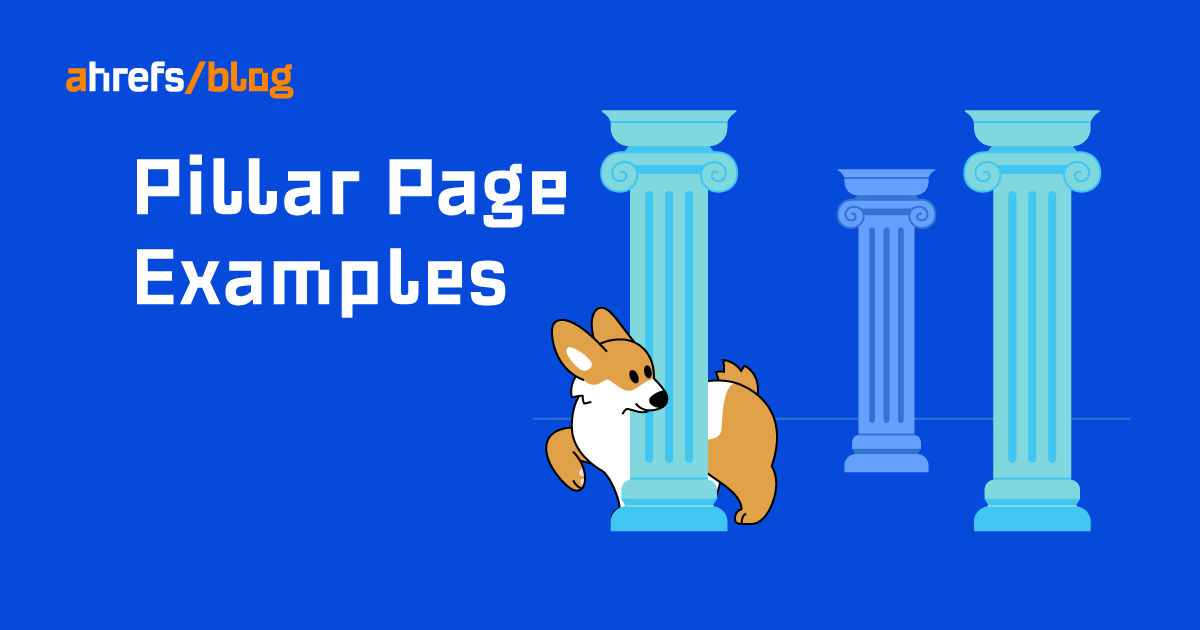
Pillar pages are high-level introductions to a topic. They then link to other pages, which are usually more detailed guides about parts of the main topic.
Altogether, they form a content hub.

But not all pillar pages look the same.
In this guide, we’ll look at eight examples of pillar pages to get your creative juices flowing.

Key stats
Estimated organic traffic: 1,200
Backlinks: 6,900
Referring domains: 899

This is our very own pillar page, covering the broad topic of search engine optimization (SEO).
Why I like it
Besides the fact that I’m biased, I like the custom design we created for this page, which makes it different from the articles on our blog.
Even though the design is custom, our pillar page is still a pretty classic “hub and spoke” style pillar page. We’ve broken the topic down neatly into six different chapters and internally linked to guides we’ve created about them. There are also custom animations when you hover over each chapter:

We’ve also added a glossary section that comes with a custom illustration of the SERPs. We have explanations of what each element means, with internal links to more detailed content:

Finally, it links to another “pillar page”: our SEO glossary.
Takeaway
Consider creating a custom design for your pillar page so that it stands out.

Key stats
Estimated organic traffic: 92,200
Backlinks: 21,600
Referring domains: 1,700

Diet Doctor is a health company focusing on low-carb diets. Its pillar page is a comprehensive guide on the keto diet.
Why I like it
On the surface, it doesn’t exactly look like a pillar page; it looks like every other post on the Diet Doctor site. But that’s perfectly fine. It’s simply a different approach—you don’t have to call out the fact that it’s a pillar page.
Diet Doctor’s guide is split into 10 different sections with links to its own resources. The links bring you to different types of content (not just blog posts but videos too).

Unlike the classic pillar page, Diet Doctor’s guide goes into enough detail for anyone who is casually researching the keto diet. But it also links to further resources for anyone who’s interested in doing additional research.
Takeaway
Pillar pages need not always just be text and links. Make it multimedia: You can add videos and images and even link to your own multimedia resources (e.g., a video course).

Key stats
Estimated organic traffic: 5,600
Backlinks: 2,800
Referring domains: 247

Wine Folly is a content site devoted to wine knowledge and appreciation. Its pillar page, as expected, is about wine.
Why I like it
Wine Folly’s pillar page is a classic example of a “hub and spoke” style pillar page—split into multiple sections, with some supporting text, and then internal links to other resources that support each subsection.

This page doesn’t just serve as a pillar page for ranking purposes, though. Given that it ranks well and receives quite a significant amount of search traffic, the page also has a call to action (CTA) to Wine Folly’s book:

Takeaway
While most websites design pillar pages for ranking, you can also use them for other purposes: capture email addresses, sell a book, pitch your product, etc.

Key stats
Estimated organic traffic: 11,100
Backlinks: 3,400
Referring domains: 457

Yoga Journal is an online and offline magazine. Its pillar page is an A-Z directory of yoga poses.
Why I like it
Yoga Journal’s pillar page is straightforward and simple. List down all possible yoga poses (in both their English and Sanskrit names) in a table form and link to them.

Since it’s listed in alphabetical order, it’s useful for anyone who knows the name of a particular pose and is interested in learning more.
What I also like is that Yoga Journal has added an extra column on the type of pose each yoga pose belongs to. If we click on any of the pose types, we’re directed to a category page where you can find similar kinds of poses:

Takeaway
The A-Z format can be a good format for your pillar page if the broad topic you’re targeting fits the style (e.g., dance moves, freestyle football tricks, etc.).

Key stats
Estimated organic traffic: 115,200
Backlinks: 3,200
Referring domains: 860

Atlassian is a software company. You’ve probably heard of its products: Jira, Confluence, Trello, etc. Its pillar page is on agile development.
Why I like it
Atlassian’s pillar page is split into different topics related to agile development. It then has internal links to each topic—both as a sticky table of contents and card-style widgets after the introduction:


I also like the “Up next” feature at the bottom of the pillar page, which makes it seem like an online book rather than a page.

Takeaway
Consider adding a table of contents to your pillar page.

Key stats
Estimated organic traffic: 114,400
Backlinks: 2,900
Referring domains: 592

Muscle and Strength’s pillar page is a massive database linking to various categories of workouts.
Why I like it
Calling it a pillar page seems to be an understatement. Muscle and Strength’s free workouts page appears to be more like a website.
When you open the page, you’ll see that it’s neatly split into multiple categories, such as “workouts for men,” “workouts for women,” “biceps,” “abs,” etc.

Clicking through to any of them leads us to a category page containing all sorts of workouts:

Compared to the other pillar pages on this list, where they’re linking to other subpages, Muscle and Strength’s pillar page links to other category pages, which then link to their subpages, i.e., its massive archive of free workouts.
Takeaway
Content databases, such as the one above, are a huge undertaking for a pillar page but can be worth it if the broad topic you’re targeting fits a format like this. Ideally, the topic should be about something where the content for it is ever-growing (e.g., workout plans, recipes, email templates, etc.).

Key stats
Estimated organic traffic: 39,100
Backlinks: 1,100
Referring domains: 308

Tofugu is a site about learning Japanese. And its pillar page is about, well, learning Japanese.
Why I like it
This is an incredible (and yes, ridiculously good) guide to learning Japanese from scratch. It covers every stage you’ll go through as a complete beginner—from knowing no Japanese to having intermediate proficiency in the language.
Unlike other pillar pages where information is usually scarce and simply links out to further resources, this page holds nothing back. Under each section, there is great detail about what that section is, why it’s important, how it works, and even an estimated time of how long that stage takes to complete.
Another interesting aspect is how Tofugu has structured its internal links as active CTAs. Rather than “Learn more” or “Read more,” it’s all about encouraging users to do a task and completing that stage.

Takeaway
Two takeaways here:
- Pillar pages can be ridiculously comprehensive. It depends on the topic you’re targeting and how competitive it is.
- CTAs can be more exciting than merely just “Read more.”

Key stats
Estimated organic traffic: 890
Backlinks: 4,100
Referring domains: 1,100

Zapier allows users to connect multiple software products together via “zaps.” It’s a 100% remote company, and its pillar page is about remote work.
Why I like it
Zapier’s pillar page is basically like Wine Folly’s pillar page. Break a topic into subsections, add a couple of links of text, and then add internal links to further resources.
In the examples above, we’ve seen all sorts of execution for pillar pages. There are those with custom designs and others that are crazily comprehensive.
But sometimes, all a pillar page needs is a simple design with links.
Takeaway
If you already have a bunch of existing content on your website, you can create a simple pillar page like this to organize your content for your readers.
Keep learning
Inspired by these examples and want to create your own pillar page? Learn how to successfully do so with these two guides:
Any questions or comments? Let me know on Twitter.
SEO
Measuring Content Impact Across The Customer Journey

Understanding the impact of your content at every touchpoint of the customer journey is essential – but that’s easier said than done. From attracting potential leads to nurturing them into loyal customers, there are many touchpoints to look into.
So how do you identify and take advantage of these opportunities for growth?
Watch this on-demand webinar and learn a comprehensive approach for measuring the value of your content initiatives, so you can optimize resource allocation for maximum impact.
You’ll learn:
- Fresh methods for measuring your content’s impact.
- Fascinating insights using first-touch attribution, and how it differs from the usual last-touch perspective.
- Ways to persuade decision-makers to invest in more content by showcasing its value convincingly.
With Bill Franklin and Oliver Tani of DAC Group, we unravel the nuances of attribution modeling, emphasizing the significance of layering first-touch and last-touch attribution within your measurement strategy.
Check out these insights to help you craft compelling content tailored to each stage, using an approach rooted in first-hand experience to ensure your content resonates.
Whether you’re a seasoned marketer or new to content measurement, this webinar promises valuable insights and actionable tactics to elevate your SEO game and optimize your content initiatives for success.
View the slides below or check out the full webinar for all the details.
SEO
How to Find and Use Competitor Keywords

Competitor keywords are the keywords your rivals rank for in Google’s search results. They may rank organically or pay for Google Ads to rank in the paid results.
Knowing your competitors’ keywords is the easiest form of keyword research. If your competitors rank for or target particular keywords, it might be worth it for you to target them, too.
There is no way to see your competitors’ keywords without a tool like Ahrefs, which has a database of keywords and the sites that rank for them. As far as we know, Ahrefs has the biggest database of these keywords.
How to find all the keywords your competitor ranks for
- Go to Ahrefs’ Site Explorer
- Enter your competitor’s domain
- Go to the Organic keywords report
The report is sorted by traffic to show you the keywords sending your competitor the most visits. For example, Mailchimp gets most of its organic traffic from the keyword “mailchimp.”


Since you’re unlikely to rank for your competitor’s brand, you might want to exclude branded keywords from the report. You can do this by adding a Keyword > Doesn’t contain filter. In this example, we’ll filter out keywords containing “mailchimp” or any potential misspellings:
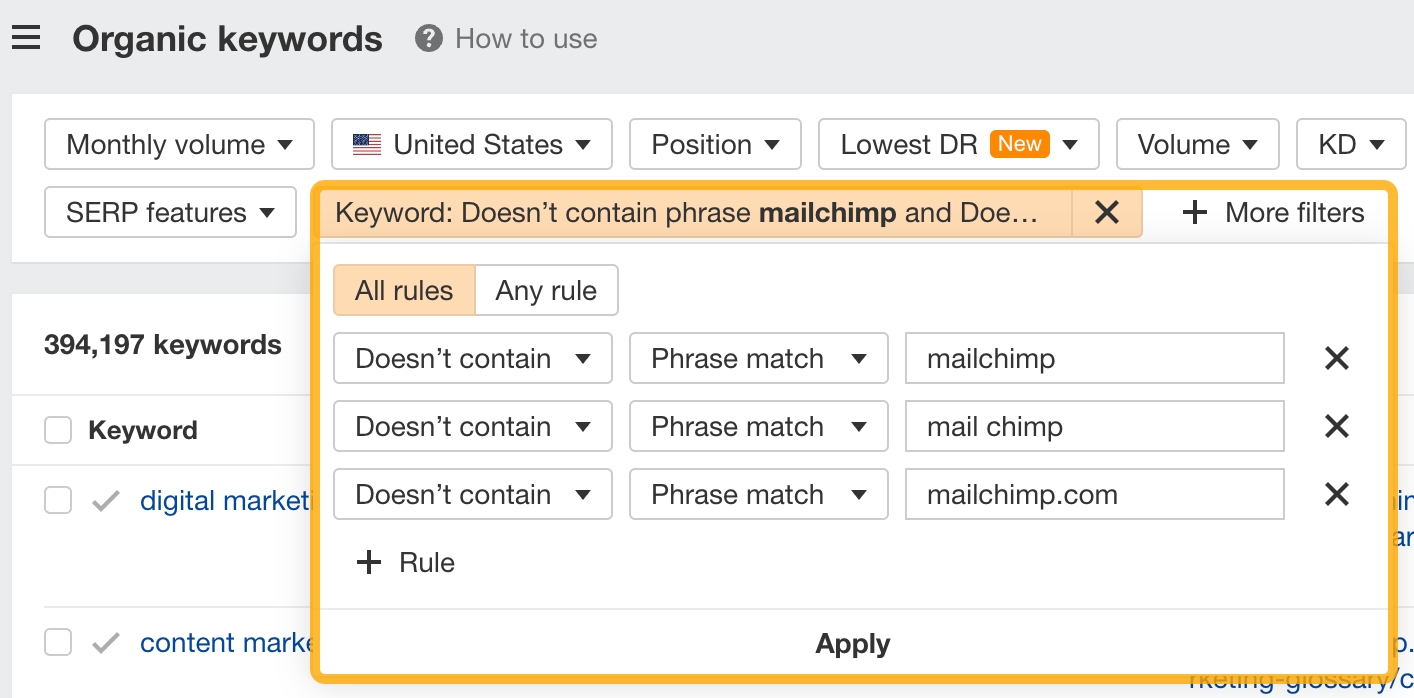

If you’re a new brand competing with one that’s established, you might also want to look for popular low-difficulty keywords. You can do this by setting the Volume filter to a minimum of 500 and the KD filter to a maximum of 10.
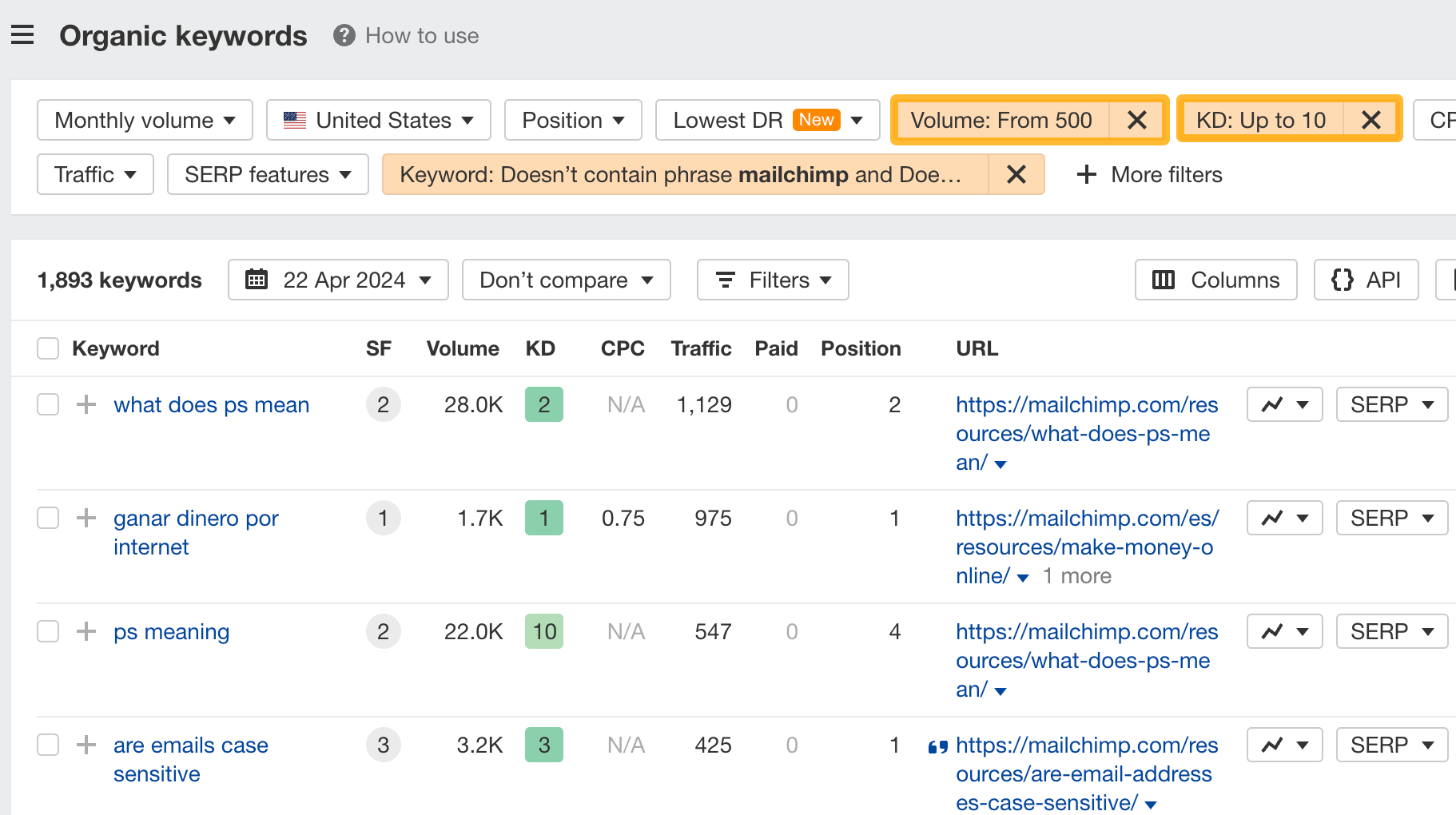

How to find keywords your competitor ranks for, but you don’t
- Go to Competitive Analysis
- Enter your domain in the This target doesn’t rank for section
- Enter your competitor’s domain in the But these competitors do section
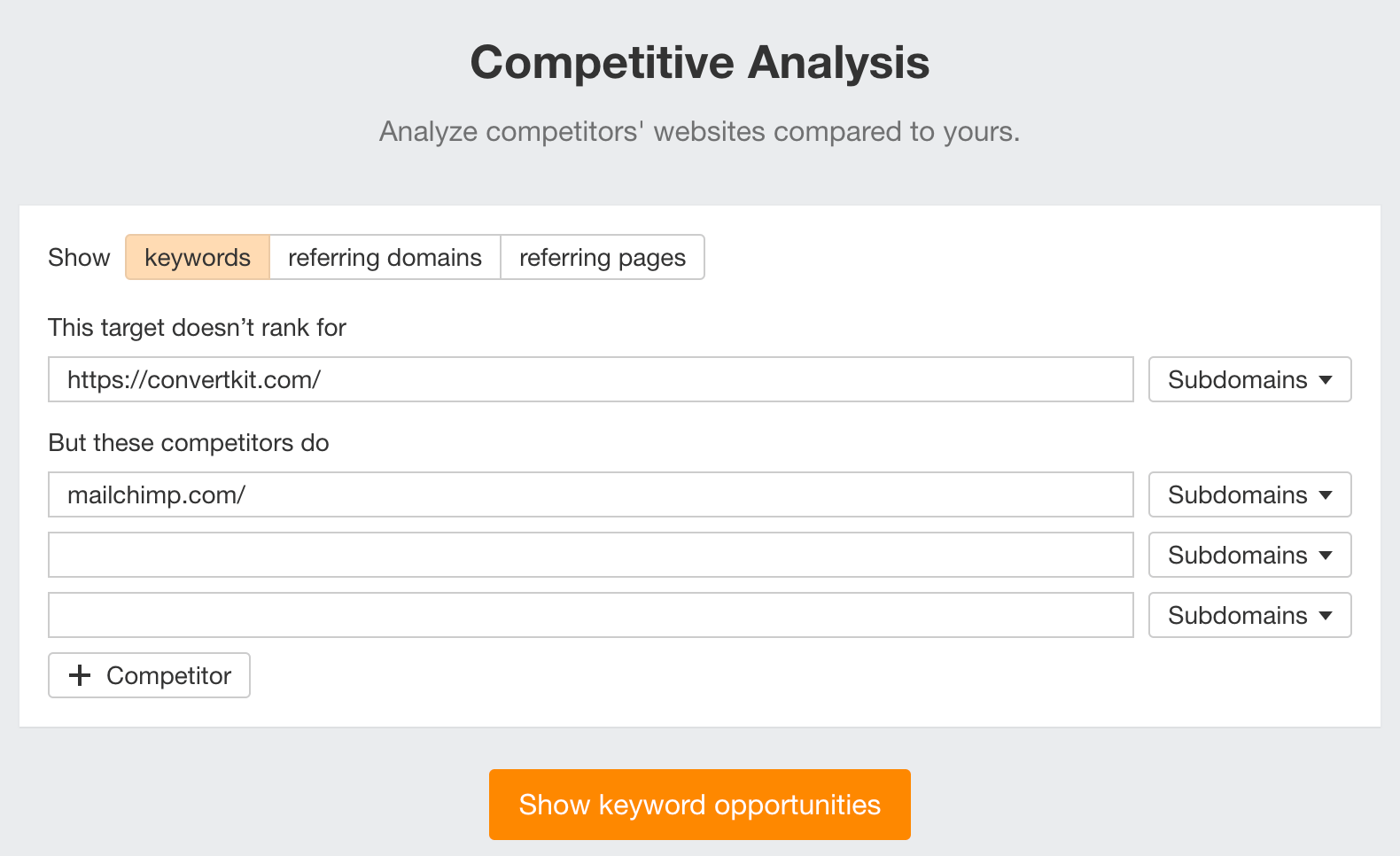

Hit “Show keyword opportunities,” and you’ll see all the keywords your competitor ranks for, but you don’t.
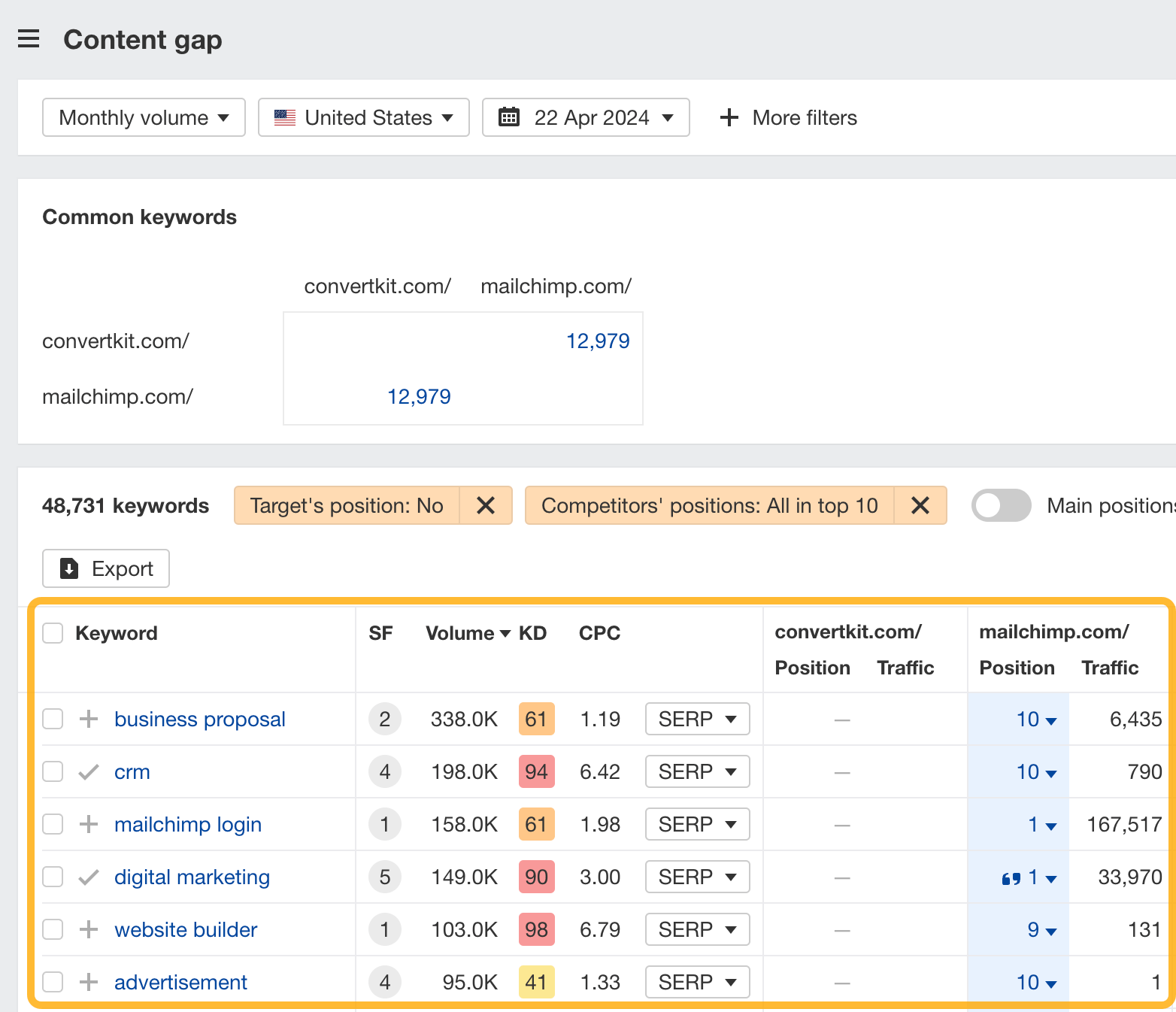

You can also add a Volume and KD filter to find popular, low-difficulty keywords in this report.
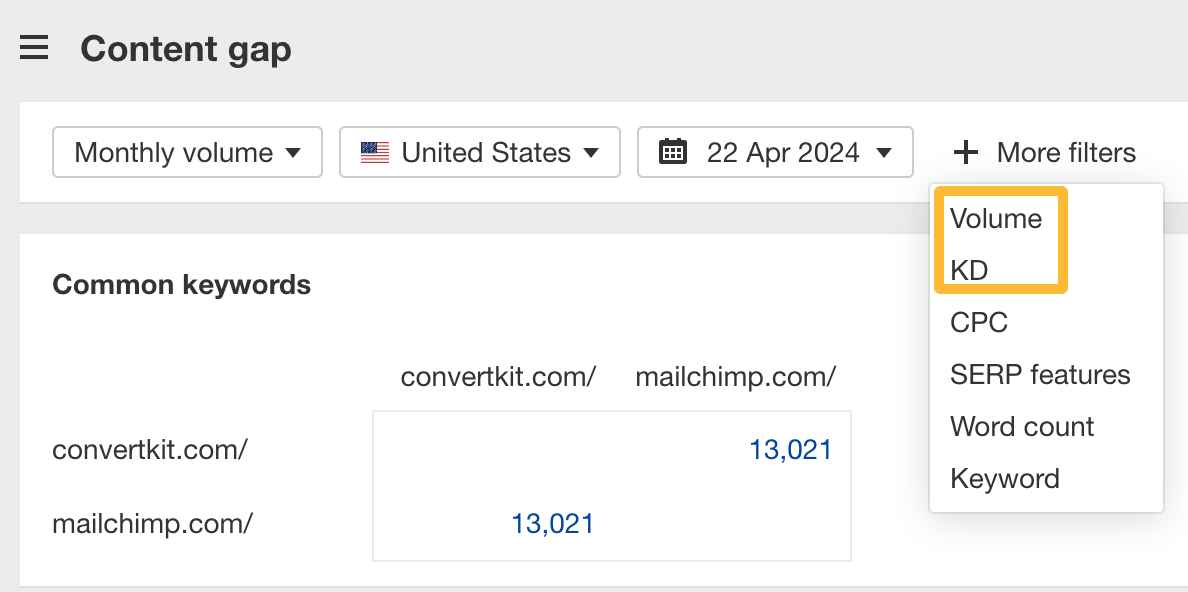

How to find keywords multiple competitors rank for, but you don’t
- Go to Competitive Analysis
- Enter your domain in the This target doesn’t rank for section
- Enter the domains of multiple competitors in the But these competitors do section
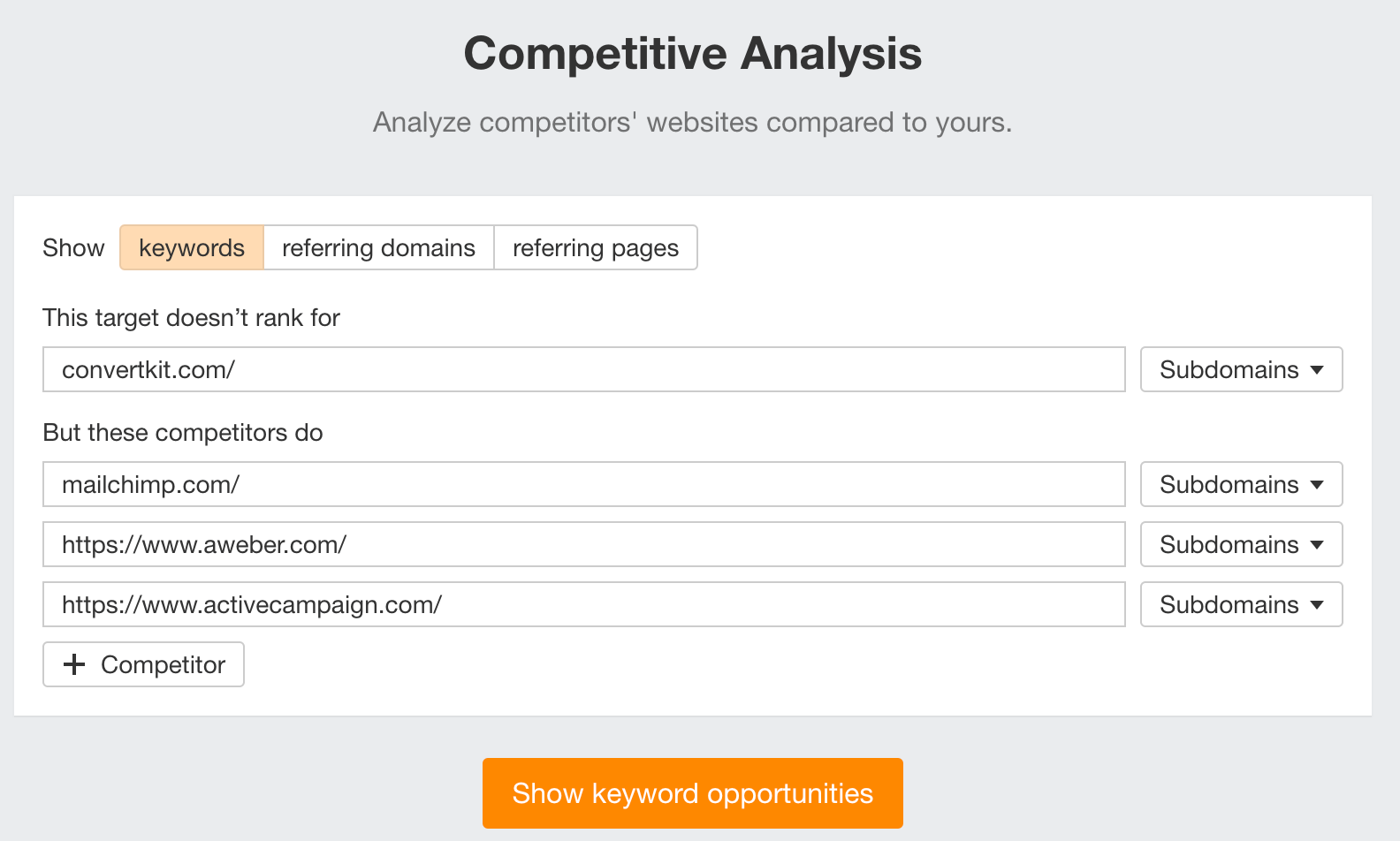

You’ll see all the keywords that at least one of these competitors ranks for, but you don’t.
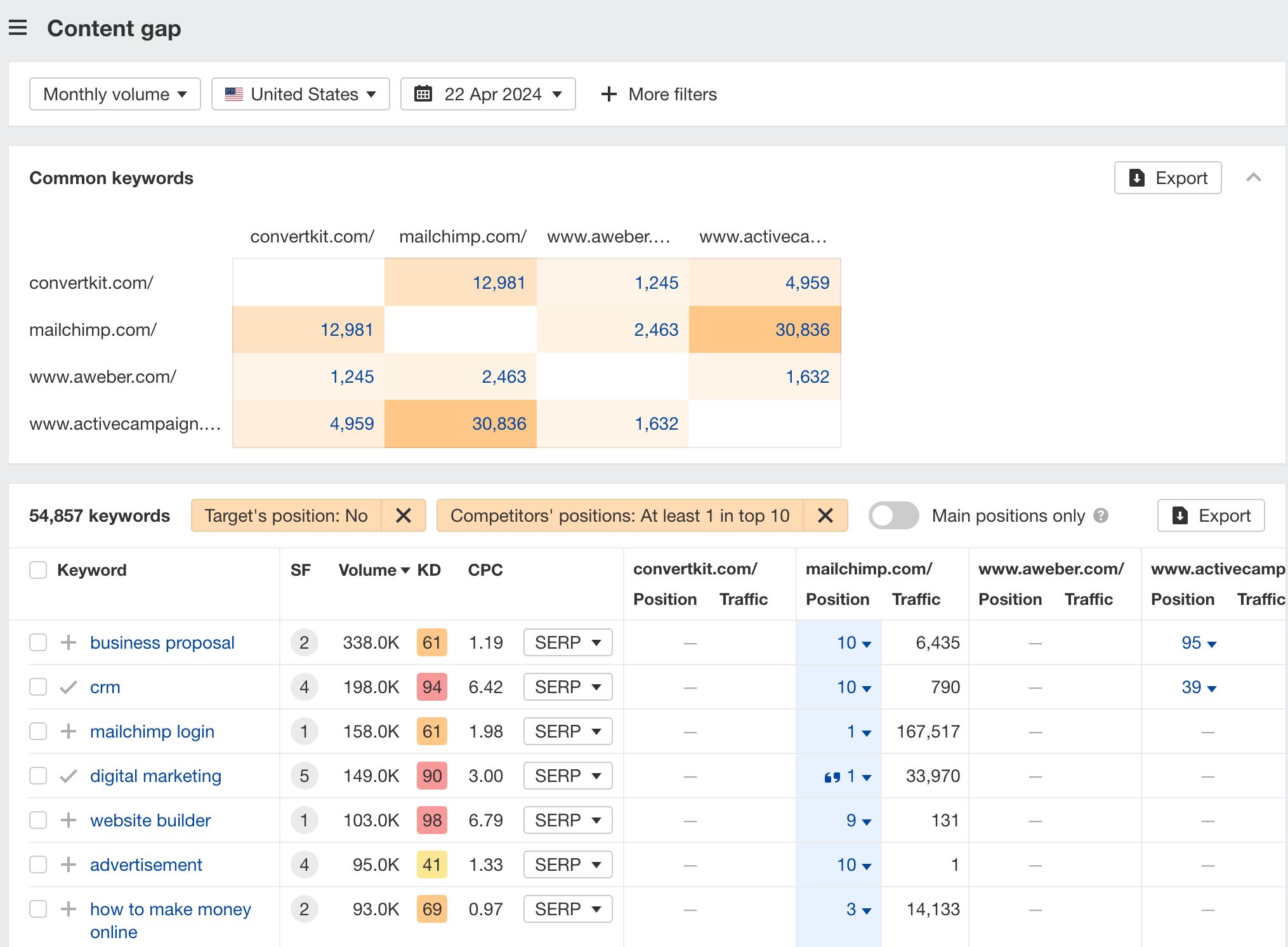

You can also narrow the list down to keywords that all competitors rank for. Click on the Competitors’ positions filter and choose All 3 competitors:
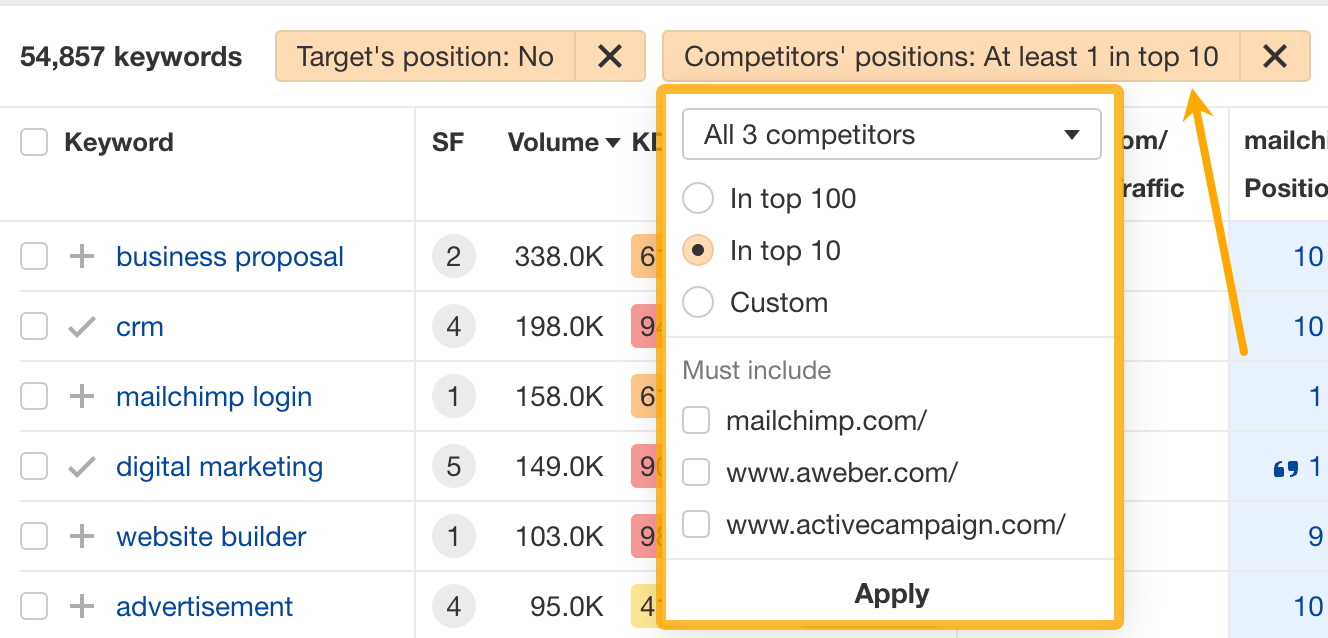

- Go to Ahrefs’ Site Explorer
- Enter your competitor’s domain
- Go to the Paid keywords report
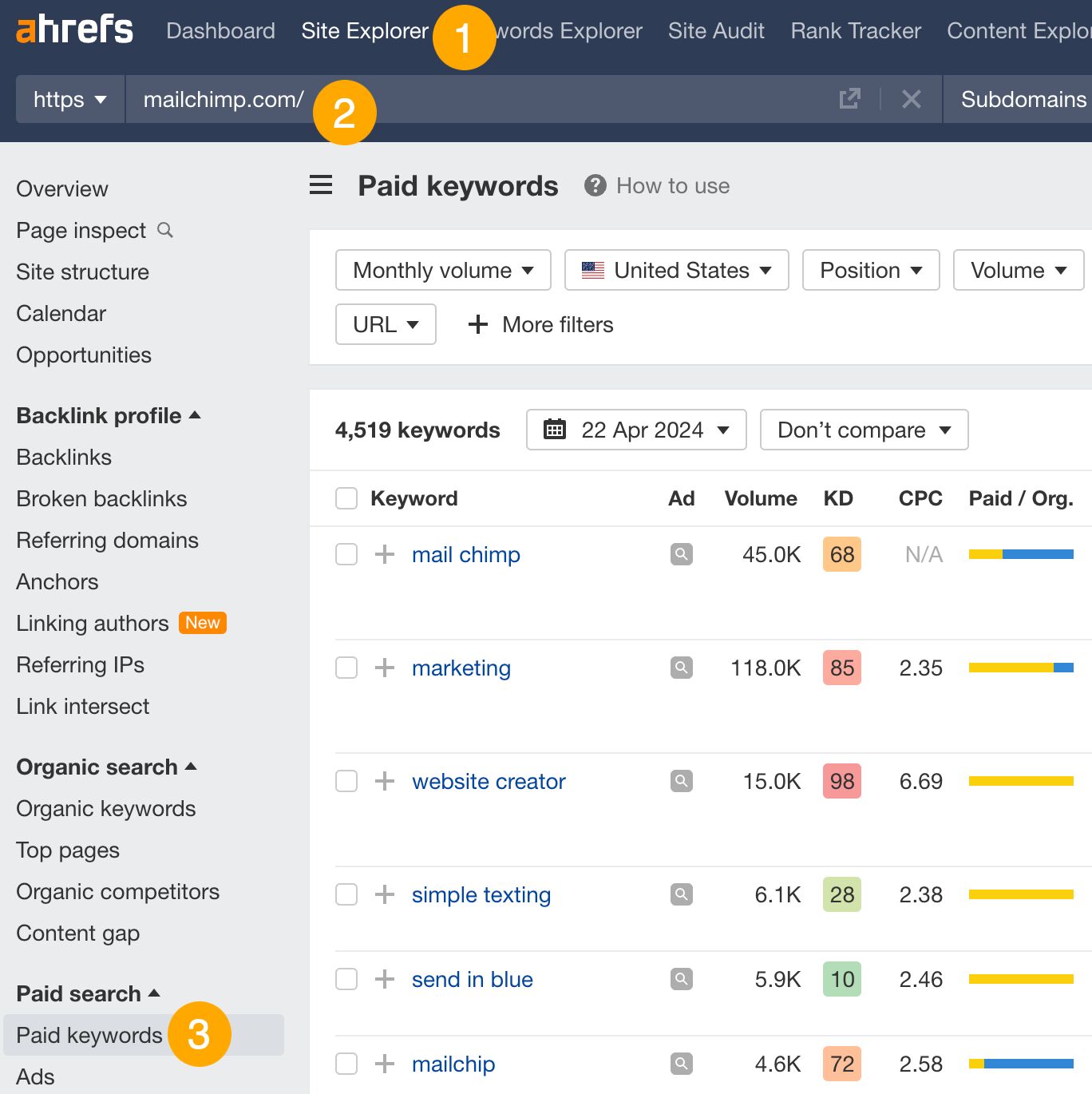

This report shows you the keywords your competitors are targeting via Google Ads.
Since your competitor is paying for traffic from these keywords, it may indicate that they’re profitable for them—and could be for you, too.
You know what keywords your competitors are ranking for or bidding on. But what do you do with them? There are basically three options.
1. Create pages to target these keywords
You can only rank for keywords if you have content about them. So, the most straightforward thing you can do for competitors’ keywords you want to rank for is to create pages to target them.
However, before you do this, it’s worth clustering your competitor’s keywords by Parent Topic. This will group keywords that mean the same or similar things so you can target them all with one page.
Here’s how to do that:
- Export your competitor’s keywords, either from the Organic Keywords or Content Gap report
- Paste them into Keywords Explorer
- Click the “Clusters by Parent Topic” tab
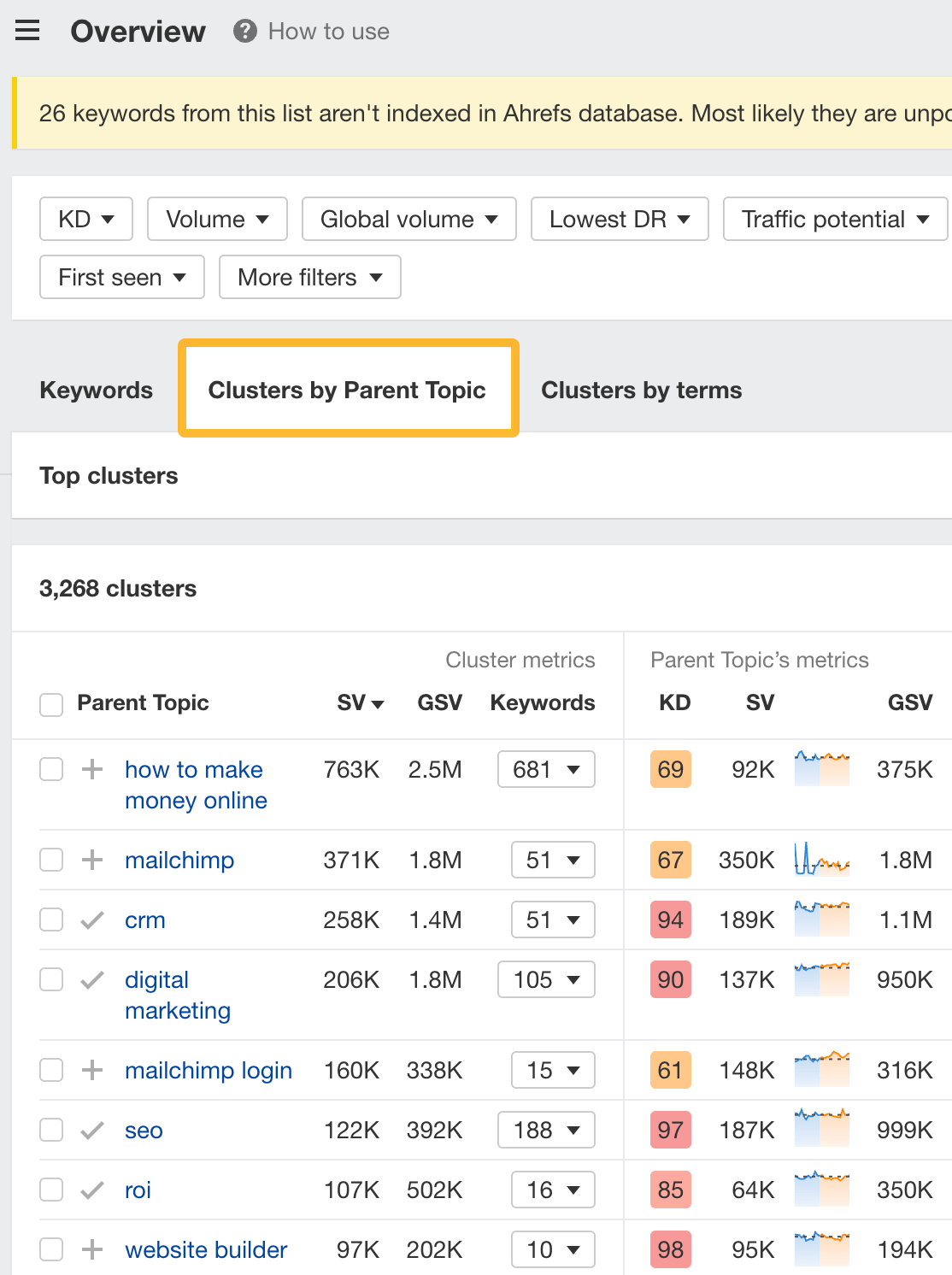

For example, MailChimp ranks for keywords like “what is digital marketing” and “digital marketing definition.” These and many others get clustered under the Parent Topic of “digital marketing” because people searching for them are all looking for the same thing: a definition of digital marketing. You only need to create one page to potentially rank for all these keywords.
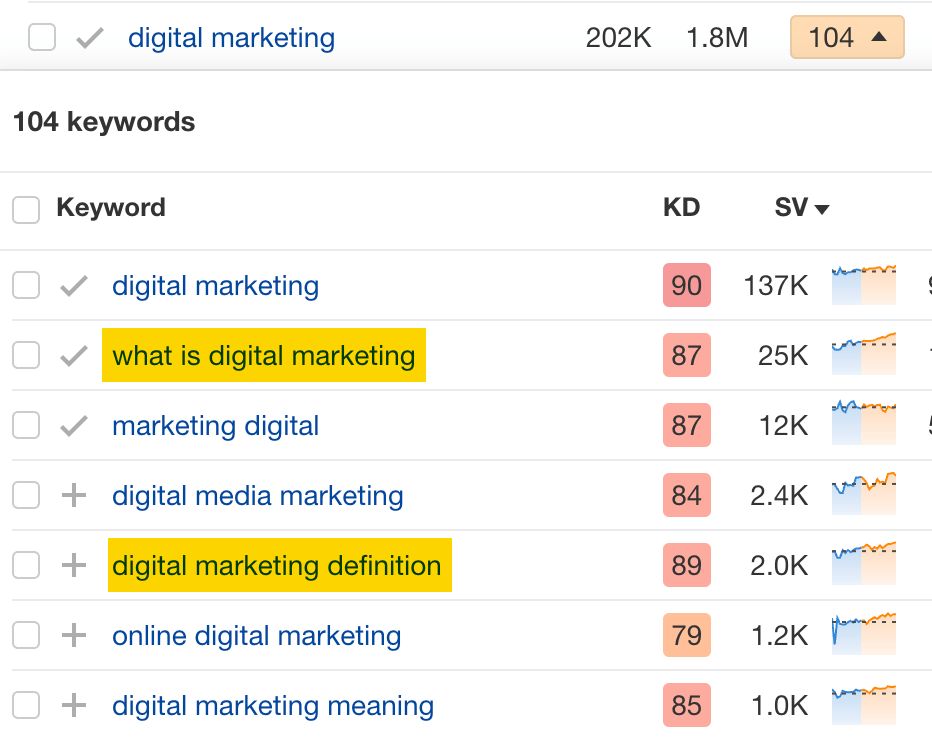

2. Optimize existing content by filling subtopics
You don’t always need to create new content to rank for competitors’ keywords. Sometimes, you can optimize the content you already have to rank for them.
How do you know which keywords you can do this for? Try this:
- Export your competitor’s keywords
- Paste them into Keywords Explorer
- Click the “Clusters by Parent Topic” tab
- Look for Parent Topics you already have content about
For example, if we analyze our competitor, we can see that seven keywords they rank for fall under the Parent Topic of “press release template.”


If we search our site, we see that we already have a page about this topic.


If we click the caret and check the keywords in the cluster, we see keywords like “press release example” and “press release format.”
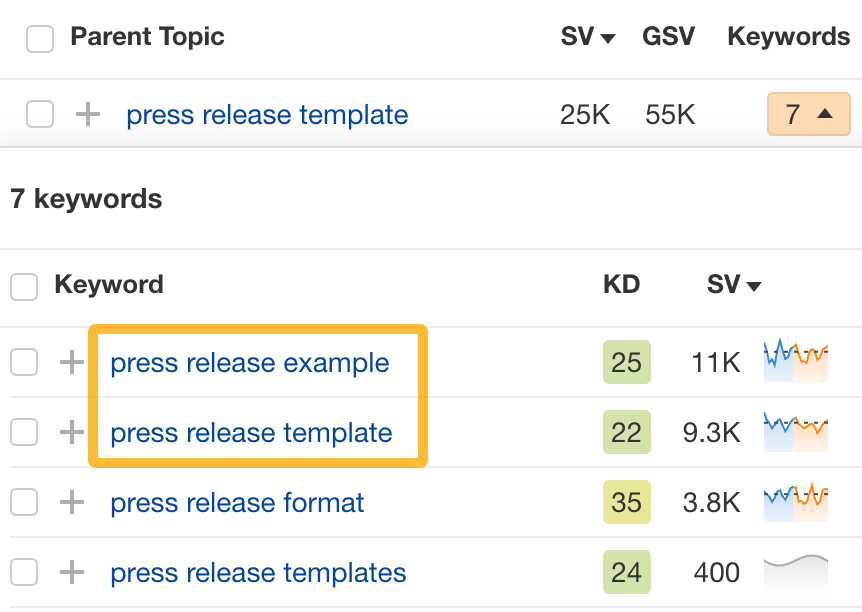

To rank for the keywords in the cluster, we can probably optimize the page we already have by adding sections about the subtopics of “press release examples” and “press release format.”
3. Target these keywords with Google Ads
Paid keywords are the simplest—look through the report and see if there are any relevant keywords you might want to target, too.
For example, Mailchimp is bidding for the keyword “how to create a newsletter.”


If you’re ConvertKit, you may also want to target this keyword since it’s relevant.
If you decide to target the same keyword via Google Ads, you can hover over the magnifying glass to see the ads your competitor is using.
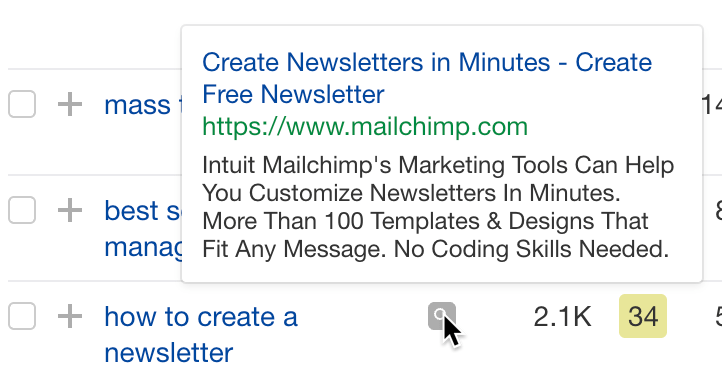

You can also see the landing page your competitor directs ad traffic to under the URL column.


Learn more
Check out more tutorials on how to do competitor keyword analysis:
SEO
Google Confirms Links Are Not That Important

Google’s Gary Illyes confirmed at a recent search marketing conference that Google needs very few links, adding to the growing body of evidence that publishers need to focus on other factors. Gary tweeted confirmation that he indeed say those words.
Background Of Links For Ranking
Links were discovered in the late 1990’s to be a good signal for search engines to use for validating how authoritative a website is and then Google discovered soon after that anchor text could be used to provide semantic signals about what a webpage was about.
One of the most important research papers was Authoritative Sources in a Hyperlinked Environment by Jon M. Kleinberg, published around 1998 (link to research paper at the end of the article). The main discovery of this research paper is that there is too many web pages and there was no objective way to filter search results for quality in order to rank web pages for a subjective idea of relevance.
The author of the research paper discovered that links could be used as an objective filter for authoritativeness.
Kleinberg wrote:
“To provide effective search methods under these conditions, one needs a way to filter, from among a huge collection of relevant pages, a small set of the most “authoritative” or ‘definitive’ ones.”
This is the most influential research paper on links because it kick-started more research on ways to use links beyond as an authority metric but as a subjective metric for relevance.
Objective is something factual. Subjective is something that’s closer to an opinion. The founders of Google discovered how to use the subjective opinions of the Internet as a relevance metric for what to rank in the search results.
What Larry Page and Sergey Brin discovered and shared in their research paper (The Anatomy of a Large-Scale Hypertextual Web Search Engine – link at end of this article) was that it was possible to harness the power of anchor text to determine the subjective opinion of relevance from actual humans. It was essentially crowdsourcing the opinions of millions of website expressed through the link structure between each webpage.
What Did Gary Illyes Say About Links In 2024?
At a recent search conference in Bulgaria, Google’s Gary Illyes made a comment about how Google doesn’t really need that many links and how Google has made links less important.
Patrick Stox tweeted about what he heard at the search conference:
” ‘We need very few links to rank pages… Over the years we’ve made links less important.’ @methode #serpconf2024″
Google’s Gary Illyes tweeted a confirmation of that statement:
“I shouldn’t have said that… I definitely shouldn’t have said that”
Why Links Matter Less
The initial state of anchor text when Google first used links for ranking purposes was absolutely non-spammy, which is why it was so useful. Hyperlinks were primarily used as a way to send traffic from one website to another website.
But by 2004 or 2005 Google was using statistical analysis to detect manipulated links, then around 2004 “powered-by” links in website footers stopped passing anchor text value, and by 2006 links close to the words “advertising” stopped passing link value, links from directories stopped passing ranking value and by 2012 Google deployed a massive link algorithm called Penguin that destroyed the rankings of likely millions of websites, many of which were using guest posting.
The link signal eventually became so bad that Google decided in 2019 to selectively use nofollow links for ranking purposes. Google’s Gary Illyes confirmed that the change to nofollow was made because of the link signal.
Google Explicitly Confirms That Links Matter Less
In 2023 Google’s Gary Illyes shared at a PubCon Austin that links were not even in the top 3 of ranking factors. Then in March 2024, coinciding with the March 2024 Core Algorithm Update, Google updated their spam policies documentation to downplay the importance of links for ranking purposes.
The documentation previously said:
“Google uses links as an important factor in determining the relevancy of web pages.”
The update to the documentation that mentioned links was updated to remove the word important.
Links are not just listed as just another factor:
“Google uses links as a factor in determining the relevancy of web pages.”
At the beginning of April Google’s John Mueller advised that there are more useful SEO activities to engage on than links.
Mueller explained:
“There are more important things for websites nowadays, and over-focusing on links will often result in you wasting your time doing things that don’t make your website better overall”
Finally, Gary Illyes explicitly said that Google needs very few links to rank webpages and confirmed it.
I shouldn’t have said that… I definitely shouldn’t have said that
— Gary 鯨理/경리 Illyes (so official, trust me) (@methode) April 19, 2024
Why Google Doesn’t Need Links
The reason why Google doesn’t need many links is likely because of the extent of AI and natural language undertanding that Google uses in their algorithms. Google must be highly confident in its algorithm to be able to explicitly say that they don’t need it.
Way back when Google implemented the nofollow into the algorithm there were many link builders who sold comment spam links who continued to lie that comment spam still worked. As someone who started link building at the very beginning of modern SEO (I was the moderator of the link building forum at the #1 SEO forum of that time), I can say with confidence that links have stopped playing much of a role in rankings beginning several years ago, which is why I stopped about five or six years ago.
Read the research papers
Authoritative Sources in a Hyperlinked Environment – Jon M. Kleinberg (PDF)
The Anatomy of a Large-Scale Hypertextual Web Search Engine
Featured Image by Shutterstock/RYO Alexandre
-

 PPC4 days ago
PPC4 days ago19 Best SEO Tools in 2024 (For Every Use Case)
-

 MARKETING7 days ago
MARKETING7 days agoWill Google Buy HubSpot? | Content Marketing Institute
-
SEARCHENGINES7 days ago
Daily Search Forum Recap: April 16, 2024
-

 SEO7 days ago
SEO7 days agoGoogle Clarifies Vacation Rental Structured Data
-

 MARKETING6 days ago
MARKETING6 days agoStreamlining Processes for Increased Efficiency and Results
-
SEARCHENGINES6 days ago
Daily Search Forum Recap: April 17, 2024
-

 PPC7 days ago
PPC7 days agoHow to Collect & Use Customer Data the Right (& Ethical) Way
-

 SEO6 days ago
SEO6 days agoAn In-Depth Guide And Best Practices For Mobile SEO
















You must be logged in to post a comment Login